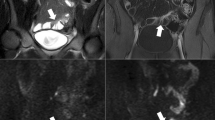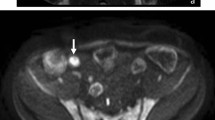Abstract
The purpose of this study was to determine whether MRE performed with diffusion-weighted imaging (DWI) sequences is comparable to contrast-enhanced MRE in the detection of active small-bowel inflammation in pediatric patients with Crohn’s disease (CD). We included in our study 68 patients with diagnosis of CD between April 2015 and June 2018 that underwent MRE examination. Examination protocol includes coronal and axial FISP, T2-w half-Fourier RARE and DWI sequences, a baseline coronal T1-w fat-saturated ultrafast (GRE) sequence followed by contrast 3D T1-w GRE. All images were assessed by two radiologists who graded each of bowel segments for the presence of inflammation on a four-point confidence scale on the basis of wall thickening and wall signal on DWI and ADC maps and comparing their results with post-contrast images. When considering all bowel segments, we found 41 true positive and 25 true negative on DWI. One false positive case corresponded to the absence of inflammatory histopathology changes at the level of the terminal ileum in a 15-year-old male, and one false negative case was in a 10-year-old female with only jejunal lesion. The corresponding sensitivity, specificity, PPV, NPV and accuracy were 97.6% (95% CI 67.7–99.7), 96.1% (95% CI 66.7–98.5), 97.6% (95% CI 70.8–98.4), 96.1% (95% CI 64.2–90.6) and 97% (95% CI 84.2–97.5), respectively. Analyzing the gadolinium-enhanced set, 35 true positive and 25 true negative results were found. One false positive case was found, and it was the same as with DWI. The corresponding sensitivity, specificity, PPV, NPV and accuracy were 83.3% (95% CI 65.9–86.7), 96.1% (95% CI 68.7–88.9), 97.2% (95% CI 84.3–98.7), 78.1% (95% CI 27.9–72.1) and 88.2% (95% CI 41.2–85.6), respectively. Sensitivity for the detection of active IBD lesion was significantly better with DWI than with CE-T1-w imaging (p = 0.002), whereas the specificity was similar (p = 0.743). Our study has shown that DWI sequences have a high accuracy in detecting the bowel segment affected by CD. These results emphasize the utility to include the DWI/ADC in standard MR enterography protocols and suggest that DWI could replace T1-weighted post-contrast sequences.



Similar content being viewed by others
References
Malaty HM, Fan X, Opekun AR et al (2010) Rising incidence of inflammatory bowel disease among children: a 12-year study. J Pediatric Gastroenterol Nutr 50(1):27–31
Dillman JR, Smith EA, Sanchez RJ et al (2015) Pediatric small bowel crohn disease: correlation of US and MR enterography. Radiographics 35(3):835–848
Masselli G, Casciani E, Polettini E et al (2013) Magnetic resonance imaging of small bowel neoplasms. Cancer Imaging 21(13):92–99
Li XH, Sun CH, Mao R et al (2015) Assessment of activity of crohn disease by diffusion-weighted magnetic resonance imaging. Medicine (Baltimore) 94(43):1819
Masselli G, Di Tola M, Casciani E et al (2016) Diagnosis of small-bowel diseases: prospective comparison of multi-detector row CT enterography with MR enterography. Radiology 279(2):420–431
La Seta F, Buccellato A, Tesè L et al (2006) Multidetector-row CT enteroclysis: indications and clinical applications. Radiol Med 111(2):141–158
Chavhan GB, Alsabban Z, Babyn PS (2014) Diffusion-weighted imaging in pediatric body MR imaging: principles, technique, and emerging applications. Radiographics 34(3):E73–E88
Neubauer H, Pabst T, Dick A et al (2013) Small-bowel MRI in children and young adults with Crohn disease: retrospective head-to-head comparison of contrast-enhanced and diffusion weighted MRI. Pediatr Radiol 43:103–114
Lee SM, Kim WS, Choi YH (2015) Pediatric magnetic resonance enterography: focused on Crohn’s disease. Pediatr Gastroenterol Hepatol Nutr 18(3):149–159
Ognibene NM, Basile M, Di Maurizio M et al (2016) Features and perspectives of MR enterography for pediatric Crohn disease assessment. Radiol Med 121(5):362–377
Seo N, Park SH, Kim KJ et al (2016) MR enterography for the evaluation of small-bowel inflammation in Crohn disease by using diffusion-weighted imaging without intravenous contrast material: a prospective noninferiority study. Radiology 278(3):762–772
Masselli G, Gualdi G (2013) CT and MR enterography in evaluating small bowel diseases: When to use which modality? Abdom Imaging 38(2):249–259
Wilkins T, Jarvis K, Patel J (2011) Diagnosis and management of Crohn’s disease. Am Fam Physician 84(12):1365–1375
Torkzad MR, Masselli G, Halligan SH et al (2015) Indications and selection of MR enterography vs. MR enteroclysis with emphasis on patients who need small bowel MRI and general anaesthesia: results of a survey. Insights Imaging 6(3):339–346
Masselli G, Gualdi G (2012) MR imaging of the small bowel. Radiology 264(2):333–348
Schooler GR, Hull NC, Mavis A, Lee EY (2019) MR imaging evaluation of inflammatory bowel disease in children where are we now in 2019. Magn Reson Imaging Clin N Am 27(2):291–300
Li Y, Hauenstein K (2015) New imaging techniques in the diagnosis of inflammatory bowel diseases. Visz Med 31(4):227–234
Masselli G, Polettini E, Laghi F et al (2014) Non-inflammatory conditions of the small bowel. Magn Reson Imaging Clin N Am 22(1):51–65
Scardapane A, Ambrosi A, Salinaro E et al (2015) Assessment of disease activity in small bowel Crohn’s disease: comparison between endoscopy and magnetic resonance enterography using MRIA and modified MRIA score. Gastroenterol Res Pract 2015:159641
Oto A, Zhu F, Kulkarni K et al (2009) Evaluation of diffusion-weighted MR imaging for detection of bowel inflammation in patients with Crohn’s disease. Acad Radiol 16:597–603
Oussalah A, Laurent V, Bruot O et al (2010) Diffusion-weighted magnetic resonance without bowel preparation for detecting colonic inflammation in inflammatory bowel disease. Gut 59:1056–1065
Kiryu S, Dodanuki K, Takao H et al (2009) Free-breathing diffusion-weighted imaging for the assessment of inflammatory activity in Crohn’s disease. J Magn Reson Imaging 29(4):880–886
Moore WA, Khatri G, Madhuranthakam AJ et al (2014) Added value of diffusion weighted acquisitions in MRI of the abdomen and pelvis. Am J Roentgenol 202:995–1006
Towbin AJ, Sullivan J, Denson Lee A et al (2013) CT and MR enterography in children and adolescents with inflammatory bowel disease. Radiographics 33(7):1843–1860
Ream JM, Dillman JR, Adler J et al (2013) MRI diffusion-weighted imaging (DWI) in pediatric small bowel Crohn disease: correlation with MRI findings of active bowel wall inflammation. Pediatr Radiol 43:1077–1085
Dubron C, Avni F, Boutry N et al (2016) Prospective evaluation of free-breathing diffusion-weighted imaging for the detection of inflammatory bowel disease with MR enterography in childhood population. Br J Radiol 89:20150840
Cappabianca S, Granata V, Di Grezia G et al (2011) The role of nasoenteric intubation in the MR study of patients with Crohn’s disease: our experience and literature review. Radiol Med 116:389–406
Masselli G, Brizi MG, Menchini L et al (2005) Magnetic resonance enteroclysis imaging of Crohn’s. Radiol Med 110(3):221–233
Church PC, Greer MC, Cytter-Kuint R et al (2017) Magnetic resonance enterography has good inter-rater agreement and diagnostic accuracy for detecting inflammation in pediatric Crohn disease. Pediatr Radiol 47(5):565–575
Qi F, Jun S, Qi QY et al (2015) Utility of the diffusion weighted imaging for activity evaluation in Crohn’s disease patients underwent magnetic resonance enterography. BMC Gastroenterol 5(15):12
Kiryu S, Watanabe M, Kabasawa H et al (2006) Evaluation of super paramagnetic iron oxide-enhanced diffusion-weighted PROPELLER T2-fast spin echo magnetic resonance imaging: preliminary experience. J Comput Assist Tomogr 30:197–200
Dohan A, Taylor S, Hoeffel C et al (2016) Diffusion-weighted MRI in Crohn’s disease: current status and recommendations. J Magn Reson Imaging 44(6):1381–1396
Gee MS, Nimkin K, Hsu M et al (2011) Prospective evaluation of MR enterography as the primary imaging modality for pediatric Crohn disease assessment. Am J Roentgenol 197:224–231
Di Mizio R, Maconi G, Romano S et al (2004) Small bowel Crohn disease: sonographic features. Abdom Imaging 29(1):23–35
Masselli G, Picarelli A, Di Tola M, Libanori V, Donato G, Polettini E, Piermattei A, Palumbo P, Pittalis A, Saponara A, Gualdi G (2010) Celiac disease: evaluation with dynamic contrast-enhanced MR imaging. Radiology 256(3):783–790
Author information
Authors and Affiliations
Corresponding author
Ethics declarations
Conflict of interest
The authors declare that there is no conflict of interest regarding the publication of this paper.
Ethical standards
The present study was conducted in accordance with the institutional ethical committee of Sapienza University of Rome.
Informed consent
Parent or guardian informed consent was obtained at the time of study enrollment.
Additional information
Publisher's Note
Springer Nature remains neutral with regard to jurisdictional claims in published maps and institutional affiliations.
Rights and permissions
About this article
Cite this article
Masselli, G., De Vincentiis, C., Aloi, M. et al. Detection of Crohn’s disease with diffusion images versus contrast-enhanced images in pediatric using MR enterography with histopathological correlation. Radiol med 124, 1306–1314 (2019). https://doi.org/10.1007/s11547-019-01067-z
Received:
Accepted:
Published:
Issue Date:
DOI: https://doi.org/10.1007/s11547-019-01067-z




